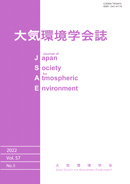
- Issue 6 Pages 129-
- Issue 5 Pages 109-
- Issue 4 Pages 101-
- Issue 3 Pages 77-
- Issue 2 Pages 35-
- Issue 1 Pages 1-
- |<
- <
- 1
- >
- >|
-
Shoichi Sakamoto, Kimiyo Kumagai, Hiroshi Tago, Seiji Sugata2022Volume 57Issue 5 Pages 109-118
Published: August 10, 2022
Released on J-STAGE: August 10, 2022
JOURNAL FREE ACCESSTo study recent changes in the photochemical oxidant (Ox) concentration, analyses were conducted using indices focusing on the daily maximum Ox concentration and diurnal Ox change during spring and summer over the Kanto Plain. Among the meteorological factors, the daily maximum temperature was strongly correlated with Ox in both seasons and a higher temperature indicated the possibility of a higher Ox. Under constant meteorological conditions in terms of sunshine duration and daily maximum temperature, these Ox indices were compared between two periods—2011–2014 and 2016–2019—and it was shown that the Ox decreased in summer with an especially significant decrease in the inland areas. The decrease in Ox during summer was presumably due to the decrease in the photochemical production caused by the decrease in the precursors (NOx and NMHC). In spring, even though the precursors decreased as in summer, these Ox indices did not decrease. It was considered that there are other factors besides local photochemical production in spring, and the effect of the decrease in the precursors was less apparent as the decrease in Ox. Furthermore, the Ox concentration reached the Ox alert level on days with meteorological conditions having a sunshine duration ≥6 h and a daily maximum temperature ≥27°C in spring and ≥35°C in summer.
View full abstractDownload PDF (1981K)
-
Itsushi Uno, Syuichi Itahashi, Yuki Yamamura, Shuhei Nakagawa, Keiya Y ...2022Volume 57Issue 5 Pages 119-127
Published: August 27, 2022
Released on J-STAGE: August 27, 2022
JOURNAL FREE ACCESSOgawa-type passive sampler (PS) measurements of NH3 were performed in the Fukuoka metropolitan area (three sites) and on Fukue Island to investigate the concentration levels and seasonal changes. The concentration levels at the three Fukuoka sites ranged from 1.5 to 3.5 ppb, and the pattern of seasonal changes was very similar. In Fukue, the NH3 concentration was lower than the concentration level at the Fukuoka sites; it ranged from 0.5 to 2 ppb with unclear seasonal variations. The NH3 PS results were compared to the filter pack (FP) measurements, and it was confirmed that the concentration levels during the warm season were almost the same. On the other hand, the NH3 PS concentrations tended to be higher as the air temperatures dropped below 15°C. This was suggested to be due to the re-volatilization of NH4NO3 trapped on the PS filter surface acting as an artefact due to NH4+→NH3. In Fukue, the NH3 level increased during March 2019 as compared to that in March 2020. This indicated that it could be due to transboundary transported NH4NO3.
View full abstractDownload PDF (3771K)
- |<
- <
- 1
- >
- >|